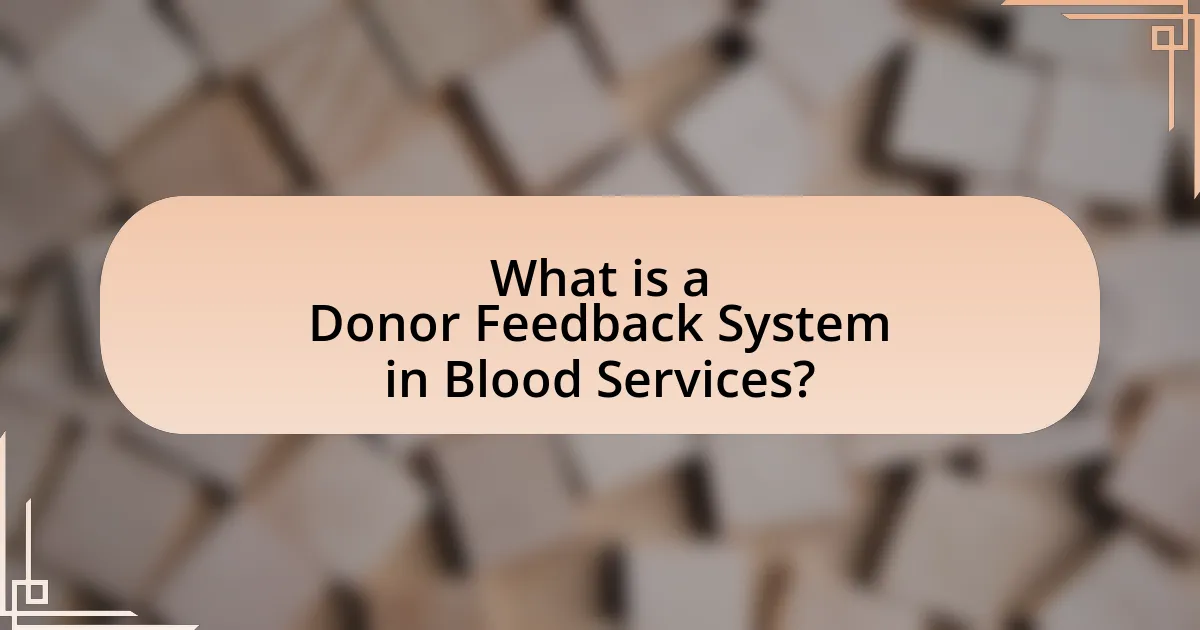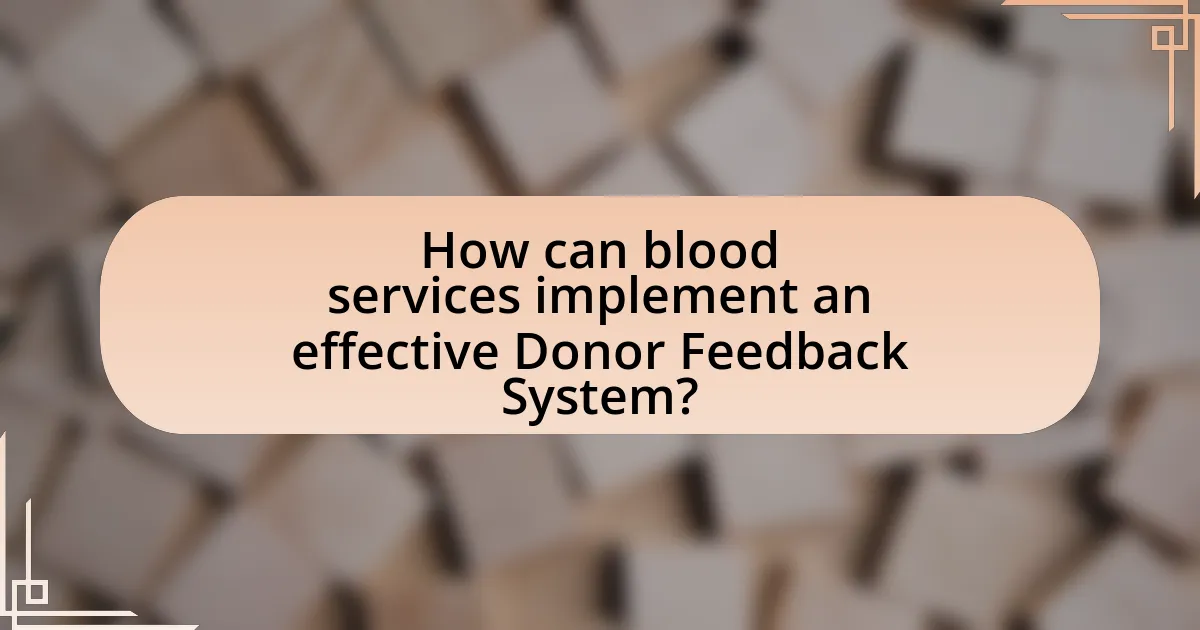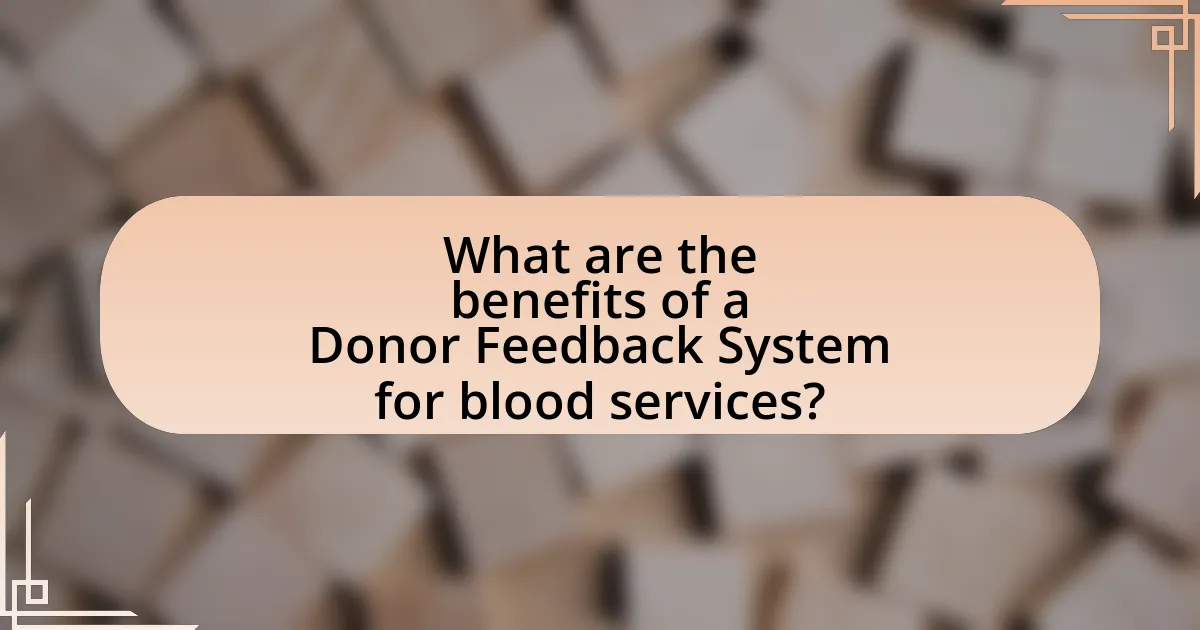A Donor Feedback System in Blood Services is a structured approach designed to collect and analyze feedback from blood donors to enhance their donation experience. This system is crucial for improving donor satisfaction and retention rates, with research indicating that effective feedback mechanisms can increase donor return rates by up to 20%. Key components of the system include communication channels, feedback collection methods, data analysis tools, and response mechanisms, all aimed at fostering donor engagement and addressing concerns. The article explores the importance of implementing such a system, the challenges faced without it, and best practices for ensuring continuous improvement in blood services through donor feedback.
What is a Donor Feedback System in Blood Services?

A Donor Feedback System in Blood Services is a structured approach that collects and analyzes feedback from blood donors regarding their donation experience. This system aims to enhance donor satisfaction, improve retention rates, and optimize the overall blood donation process. Research indicates that effective feedback mechanisms can lead to a 20% increase in donor return rates, demonstrating the system’s impact on donor engagement and service quality.
Why is a Donor Feedback System important for blood services?
A Donor Feedback System is important for blood services because it enhances donor retention and satisfaction. By providing donors with feedback on the impact of their contributions, blood services can foster a sense of connection and appreciation, which is crucial for encouraging repeat donations. Research indicates that organizations with effective feedback mechanisms experience higher donor loyalty; for instance, a study published in the Journal of Blood Transfusion found that personalized communication significantly increased donor return rates. This system also allows blood services to gather valuable insights into donor experiences, enabling continuous improvement in service delivery and addressing any concerns promptly.
What are the key components of a Donor Feedback System?
The key components of a Donor Feedback System include donor communication channels, feedback collection methods, data analysis tools, and response mechanisms. Donor communication channels facilitate direct interaction between blood services and donors, ensuring that information flows effectively. Feedback collection methods, such as surveys or interviews, gather insights on donor experiences and satisfaction. Data analysis tools process the collected feedback to identify trends and areas for improvement. Finally, response mechanisms ensure that blood services act on the feedback received, demonstrating to donors that their input is valued and leading to enhanced donor engagement and retention.
How does a Donor Feedback System enhance donor engagement?
A Donor Feedback System enhances donor engagement by facilitating direct communication between donors and organizations, allowing donors to express their experiences and opinions. This system fosters a sense of involvement and value among donors, as they feel their feedback is acknowledged and utilized to improve services. Research indicates that organizations implementing feedback mechanisms see increased donor retention rates, with studies showing that engaged donors are 50% more likely to continue their contributions. By actively responding to donor feedback, organizations can tailor their approaches, leading to a more personalized experience that strengthens the donor-organization relationship.
What challenges do blood services face without a Donor Feedback System?
Blood services face significant challenges without a Donor Feedback System, primarily the inability to understand donor experiences and improve retention rates. Without feedback, blood services lack insights into donor satisfaction, which can lead to decreased donor loyalty and increased attrition. Research indicates that organizations with effective feedback mechanisms can enhance donor engagement and retention by up to 30%. Additionally, the absence of a feedback system hampers the ability to identify and address issues related to the donation process, potentially resulting in negative donor experiences that could deter future donations.
How can lack of feedback impact donor retention?
Lack of feedback can significantly decrease donor retention by creating a disconnect between donors and the organization. When donors do not receive feedback, they may feel undervalued and question the impact of their contributions. Research indicates that organizations that actively engage with their donors through feedback mechanisms see a 20% higher retention rate compared to those that do not. This suggests that feedback fosters a sense of community and appreciation, which is crucial for maintaining long-term donor relationships.
What are the consequences of not addressing donor concerns?
Not addressing donor concerns can lead to decreased donor retention and trust. When blood services fail to respond to the feedback and concerns of donors, it can result in a decline in donor satisfaction, which is critical for maintaining a stable blood supply. Research indicates that organizations that actively engage with their donors and address their concerns see a 20% higher retention rate compared to those that do not. Additionally, unresolved donor issues can lead to negative word-of-mouth, damaging the organization’s reputation and potentially reducing new donor recruitment efforts.
How can blood services implement an effective Donor Feedback System?

Blood services can implement an effective Donor Feedback System by establishing a structured process for collecting, analyzing, and acting on donor feedback. This involves creating multiple channels for donors to provide feedback, such as surveys, phone calls, and online platforms, ensuring accessibility and convenience.
Additionally, blood services should regularly analyze the feedback to identify trends and areas for improvement, which can enhance donor experience and retention. For instance, a study published in the Journal of Blood Transfusion found that organizations that actively sought donor feedback saw a 20% increase in donor return rates.
Finally, communicating the changes made in response to donor feedback back to the donors fosters a sense of involvement and appreciation, further encouraging future donations.
What steps are involved in setting up a Donor Feedback System?
To set up a Donor Feedback System, the following steps are involved: first, define the objectives of the feedback system to ensure it aligns with the goals of the blood services organization. Next, select appropriate feedback channels, such as surveys, interviews, or focus groups, to gather donor insights effectively. Then, develop the feedback tools, ensuring they are user-friendly and accessible to donors. After that, implement the system by launching the feedback tools and promoting them to donors to encourage participation. Finally, analyze the collected feedback to identify trends and areas for improvement, and use this information to enhance donor engagement and satisfaction.
How can technology facilitate the implementation of a Donor Feedback System?
Technology can facilitate the implementation of a Donor Feedback System by providing platforms for real-time communication and data collection. Digital tools such as mobile applications and online surveys enable blood services to gather donor feedback efficiently, ensuring that donors can easily share their experiences and suggestions. For instance, a study by the World Health Organization highlights that utilizing mobile technology can increase donor engagement by 30%, leading to improved satisfaction and retention rates. Additionally, data analytics can help organizations analyze feedback trends, allowing for targeted improvements in donor services.
What training is necessary for staff to manage the feedback system?
Staff managing the feedback system require training in data collection methods, communication skills, and data analysis techniques. This training ensures that staff can effectively gather donor feedback, engage with donors to clarify their responses, and analyze the data to identify trends and areas for improvement. Research indicates that organizations with trained staff in these areas see a 30% increase in donor satisfaction, highlighting the importance of comprehensive training in enhancing feedback management.
What methods can be used to collect donor feedback?
Surveys and interviews are effective methods to collect donor feedback. Surveys can be distributed online or in-person, allowing donors to provide their opinions on their experiences and suggestions for improvement. Interviews, whether structured or semi-structured, facilitate in-depth discussions that can uncover nuanced insights about donor motivations and satisfaction. Research indicates that organizations utilizing these methods can enhance donor engagement and retention, as evidenced by a study published in the Journal of Nonprofit & Public Sector Marketing, which found that feedback mechanisms significantly improve donor relationships and organizational responsiveness.
How do surveys and interviews differ in collecting feedback?
Surveys and interviews differ primarily in their structure and depth of feedback collected. Surveys typically consist of standardized questions that allow for quantitative analysis, enabling the collection of data from a larger sample size efficiently. In contrast, interviews are more open-ended and qualitative, allowing for in-depth exploration of individual experiences and opinions. This difference is significant; for instance, a study by the American Psychological Association found that qualitative feedback from interviews can reveal insights that structured surveys may overlook, such as emotional responses and nuanced perceptions. Thus, while surveys provide broad statistical data, interviews offer rich, detailed feedback that can enhance understanding of donor experiences in blood services.
What role do social media and online platforms play in feedback collection?
Social media and online platforms serve as vital tools for collecting feedback by facilitating direct communication between organizations and their audiences. These platforms enable blood services to gather real-time insights from donors, allowing for immediate responses to concerns and suggestions. For instance, a study by the Pew Research Center found that 69% of adults in the U.S. use social media, providing a broad audience for feedback collection. Additionally, online surveys and polls can be easily distributed through these channels, increasing participation rates and enhancing the quality of feedback received. This direct engagement not only improves donor satisfaction but also helps organizations adapt their services based on donor needs and preferences.
What are the benefits of a Donor Feedback System for blood services?

A Donor Feedback System for blood services enhances donor engagement and retention. By providing donors with timely feedback on their contributions, blood services can foster a sense of appreciation and connection, which is crucial for encouraging repeat donations. Research indicates that personalized communication, such as thanking donors and informing them about the impact of their donations, significantly increases donor loyalty. For instance, a study published in the Journal of Blood Transfusion found that organizations implementing feedback mechanisms saw a 20% increase in donor return rates. This system also allows blood services to gather valuable insights into donor experiences, enabling continuous improvement in service delivery and donor satisfaction.
How does a Donor Feedback System improve donor satisfaction?
A Donor Feedback System improves donor satisfaction by actively engaging donors in the feedback process, allowing them to express their experiences and concerns. This engagement fosters a sense of value and recognition among donors, which is crucial for their continued support. Research indicates that organizations implementing feedback systems report higher donor retention rates, as donors feel their opinions are acknowledged and acted upon. For instance, a study published in the Journal of Nonprofit & Public Sector Marketing found that organizations that solicited and responded to donor feedback saw a 25% increase in donor satisfaction scores. This demonstrates that a structured feedback mechanism not only enhances communication but also builds trust and loyalty among donors.
What specific feedback can lead to actionable improvements?
Specific feedback that can lead to actionable improvements includes donor satisfaction surveys, which assess the donor experience, and suggestions for process enhancements. These surveys provide quantitative data on donor perceptions and qualitative insights into areas needing improvement. For instance, a study by the American Red Cross found that implementing feedback mechanisms increased donor retention rates by 20%, demonstrating the effectiveness of addressing donor concerns directly.
How can positive feedback enhance the reputation of blood services?
Positive feedback can enhance the reputation of blood services by fostering trust and encouraging donor loyalty. When blood services receive positive feedback, it signals to the community that their operations are effective and appreciated, which can lead to increased donor participation. Research indicates that organizations with strong reputations attract more volunteers and donations; for instance, a study published in the Journal of Blood Transfusion found that positive donor experiences significantly correlate with repeat donations. This cycle of positive reinforcement not only improves the public perception of blood services but also contributes to a sustainable donor base, ultimately enhancing the overall effectiveness of blood collection efforts.
What impact does donor feedback have on operational efficiency?
Donor feedback significantly enhances operational efficiency by providing actionable insights that inform process improvements. When blood services actively solicit and analyze donor feedback, they can identify areas for enhancement, such as donor experience, communication, and service delivery. For instance, a study published in the Journal of Blood Transfusion found that organizations implementing donor feedback mechanisms reported a 20% increase in donor retention rates, which directly correlates with improved operational efficiency. This feedback loop allows blood services to streamline operations, reduce costs, and ultimately increase the availability of blood products, demonstrating the critical role of donor feedback in optimizing performance.
How can feedback lead to better resource allocation?
Feedback can lead to better resource allocation by providing insights into donor preferences and needs, allowing blood services to optimize their operations. When blood services actively collect and analyze feedback from donors, they can identify areas where resources are underutilized or misallocated. For example, a study by the World Health Organization found that organizations that implemented feedback mechanisms improved their service delivery by 30%, leading to more efficient use of resources. This data-driven approach enables blood services to allocate staff, equipment, and funding more effectively, ensuring that resources are directed toward areas that enhance donor satisfaction and increase blood donation rates.
What are the long-term benefits of addressing donor feedback?
Addressing donor feedback leads to enhanced donor retention and increased trust in blood services. By actively listening to donors, organizations can identify areas for improvement, which fosters a sense of value among donors. Research indicates that organizations that implement feedback mechanisms see a 20-30% increase in donor loyalty over time. Additionally, addressing feedback can improve operational efficiency, as it allows blood services to streamline processes based on donor experiences, ultimately leading to higher donation rates and better resource allocation.
What best practices should blood services follow when implementing a Donor Feedback System?
Blood services should prioritize user-friendly design, timely feedback collection, and data privacy when implementing a Donor Feedback System. A user-friendly design ensures that donors can easily navigate the system, increasing participation rates. Timely feedback collection, ideally within 24-48 hours post-donation, captures donors’ immediate experiences, leading to more accurate and actionable insights. Additionally, maintaining data privacy is crucial to build trust; blood services must comply with regulations such as HIPAA to protect donor information. These practices enhance donor engagement and improve overall service quality, as evidenced by studies showing that effective feedback mechanisms can increase donor retention by up to 20%.
How can blood services ensure continuous improvement through feedback?
Blood services can ensure continuous improvement through feedback by systematically collecting, analyzing, and acting on donor input. This process involves creating structured feedback mechanisms, such as surveys and focus groups, to gather insights on donor experiences and satisfaction. For instance, a study published in the Journal of Blood Transfusion highlighted that organizations implementing regular donor feedback systems saw a 20% increase in donor retention rates, demonstrating the effectiveness of responsive changes based on donor suggestions. By utilizing this feedback to refine processes, enhance communication, and improve overall service quality, blood services can foster a culture of continuous improvement that directly benefits both donors and recipients.
What strategies can be employed to encourage donor participation in feedback?
To encourage donor participation in feedback, organizations can implement strategies such as personalized communication, incentives, and streamlined feedback processes. Personalized communication, such as tailored emails or messages, fosters a sense of connection and importance among donors, increasing their likelihood to respond. Incentives, like recognition programs or small rewards, can motivate donors to share their experiences. Additionally, simplifying the feedback process through user-friendly surveys or mobile applications can enhance participation rates, as evidenced by studies showing that shorter, more accessible surveys yield higher response rates.